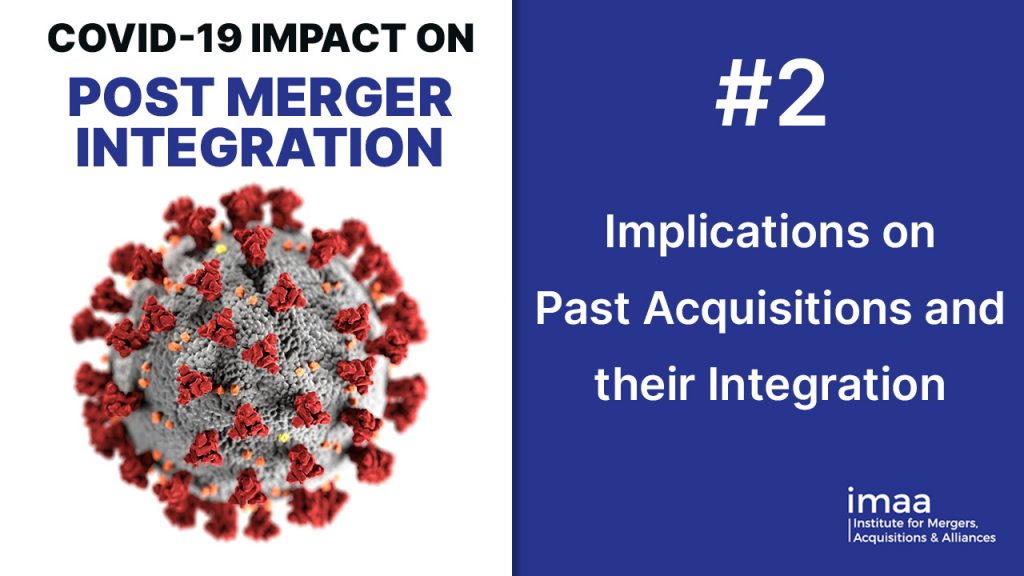
Blog Impact on Covid 19 on Past Acquisitions and their Integration
- Blog
Impact on Covid 19 on Past Acquisitions and their Integration
- Christopher Kummer

SHARE:

After reviewing the impact of COVID on currently ongoing post-merger integration projects in our first article of this series, let’s have a look at the impact on companies with acquisitions in the previous few years, their integration efforts and end results.
This impact may be even higher than for ongoing post-merger integration projects, because if you have not done your homework in the past and missed that window of opportunity for a best in class integration, the effect on the business will be severe.
For companies that have failed to properly integrate their past acquisitions, the current economic climate will punish them more than their competition. They will be less competitive at a lower profitability, if not even shift into a loss-making situation sooner than any of their competitors.
These companies are encouraged to:
- Review past acquisitions and assess integration approach, level of integration and results
- Restructure and spin-off for eventual sale
- Plan for integration efforts
- Appropriately staff this integration project
Companies should be encouraged to review their past acquisitions and critically analyse the approach which they have taken. For example, in its most extreme form of integration approach, a company may have opted against integrating the acquired company (standalone approach). In the current environment, companies will have to reassess their integration rational and proceed accordingly.
Regardless of the integration approach taken, companies may need to reassess their goals and targets that had been outlined in the beginning of the process. Companies will also have to realistically measure if the acquisition goals have been met. This would be pivotal, if the required company is not a true fit anymore, the acquirer may want to consider a spin off and restructure the business. This would allow the acquirer to prepare an eventual sale when the M&A market shows promising signs.
While integration well-beyond the acquisition is always more difficult as the compelling need to integration post-close has gone, a little reframing may be helpful: this situation could in fact be seen as an opportunity rather than just a challenge, one that in fact comes with two in-built advantages: The Coronavirus pandemic is forcing businesses to find ways to cut costs and improve cashflow, and unintegrated acquisitions are likely to be the best place to find ‘money left on the table’ vs. other parts of your organisation. Cost-cutting initiatives should start by reviewing past acquisitions and seeing if they can discover ‘hidden nuggets’ of synergy that will help them, synergies that were never realised in the first place, even if relatively easy to deliver. The second benefit of the situation is that the compelling need to change and readiness of customers and employees to accept some necessary disruption – long gone with the completion of the original deal – has now reappeared with the pressures of Covid-19. As the saying goes, “never let a good crisis go to waste.” Use this opportunity as much as you can (as opposed to as much as you need) to make your business leaner and more agile. Darwin’s theory of evolution comes directly into play here: survival of the fittest organisation favours those that are most adaptable to new circumstances, and events such as this help those adaptable organisations survive and thrive.
Companies will have to plan for a new integration effort (also referred to as the second wave integration). Planning for a new integration in the current environment will add a whole set of challenges as the window of opportunity for any immediate change post integration would have been long gone. Right after an acquisition, employees expect and are more open to change. While if years later you launch these efforts, you can expect more resistance.
When executing this new integration, companies will need to think carefully about how to staff this integration project. In contrast to normal integration projects, there is need for further involvement and increased capacity form the major senior leadership and decision makers– something one can’t delegate to project management. All the other factors that usually apply to integration projects, of also apply here (if you missed our first article on the effect of COVID on PMI, please have a look).
Another challenge that does come with integrating old acquisitions is the availability of individuals who were part of the original acquisition process or deal business case, but who may have moved on since the original deal. Even if no longer with the business, it may be worth trying to find and spend some time with them to get a better understanding of why integration wasn’t conducted (or successfully completed); and to gain insight into some of the assumptions that may have underpinned the business case. Supplemented with an up-to-date reassessment of the synergy opportunities and reconsideration of potential operating model options (that would e.g. deliver leaner organisational structures, more efficient processes, integration IT systems, etc.), this insight can accelerate your ability to deliver quick wins, which may be critical in a cash-constrained business.

TAGS:


Stay up to date with M&A news!
Subscribe to our newsletter


